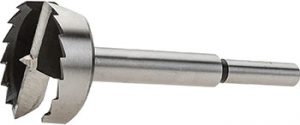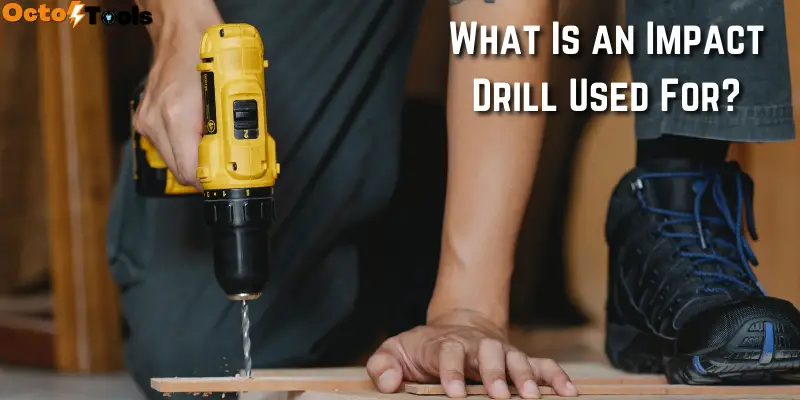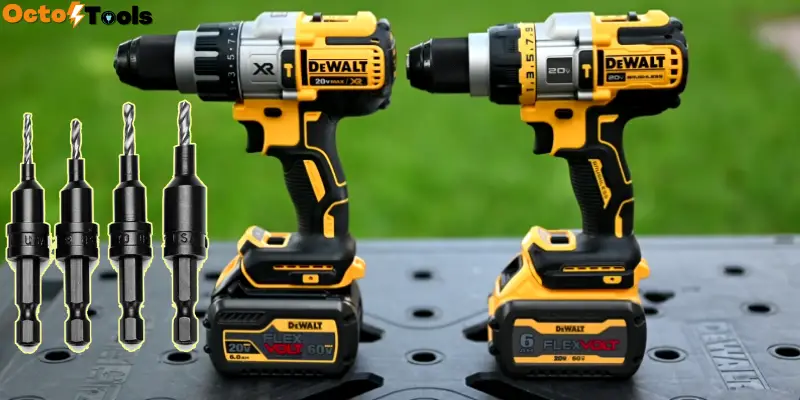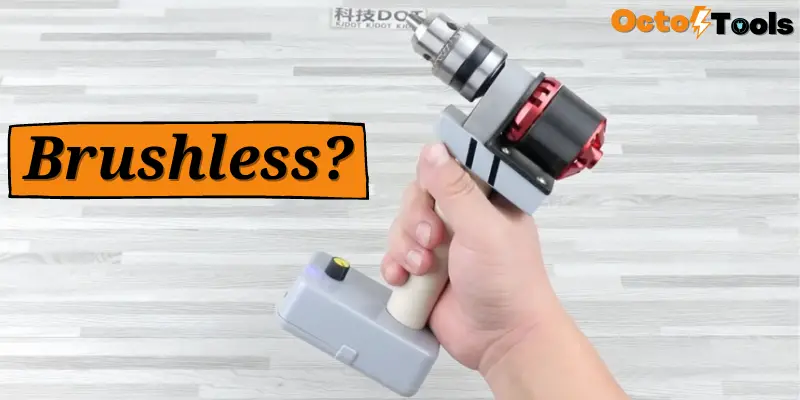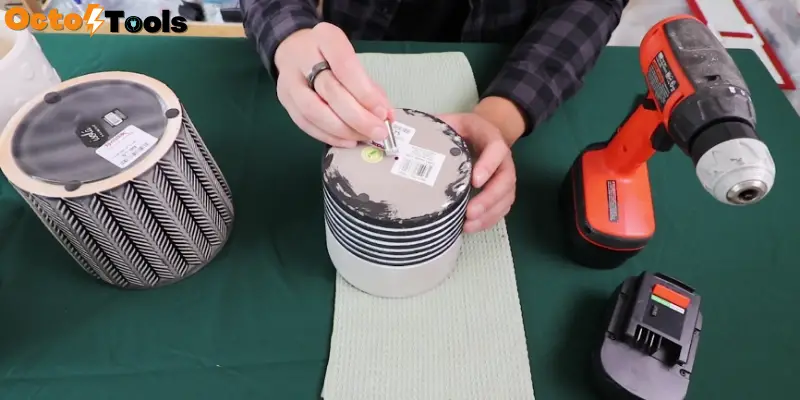Both types of bits are used for drilling holes. Apart from that, there are lots of differences between them. So, knowing the Forstner bit vs spade bit comparison in detail will help you choose the right one for your job.
Alongside the definitions, I have also described their applications, advantages, disadvantages, and listed some of the best products from each type.
Make yourself free from all distractions and read till the end carefully without skipping any part. Let’s get started
What is a Spade Bit?
A spade bit is a wide and flat blade for drilling holes into the wood. It is also commonly called a paddle bit as its shape resembles a paddle. The drilling bit has a pointy tip in the middle for guidance with two sharp tips for cutting through.
Not only just woodworking but this bit can also be used on the wall for utility installation. Electricians and plumbers use this besides the auger bits and hole saws to make holes on the wall.
It’s inexpensive and can make larger holes than the twisted drill bits. On top of that, it’s faster than most of the bits available. As the contact area is less, it doesn’t get heated quickly too. People use it when the cleanliness of the hole doesn’t matter much.
What is a Forstner Bit?
Benjamin Forstner invented this brilliant drill bit in 1886. It’s circular in shape having a cutting rim around the perimeter and a pointy tip in the center for guidance. It cuts an absolutely precise, clean-edged hole through the wood.
So, why would I use a Forstner bit?
People use it in accurate boring operations like hardware installation where the mortise’s depth needs to be exact.
The only drawback it has that it tends to skate or slip across the top of the material. So, to get the best results it’s used with a drill press at 90◦, or at an angle. This versatile bit is even used to make overlapping holes or holes that hang on the edge of a workpiece. Forstner bits are available in different kinds of rims and sizes.
Forstner Bit Vs Spade Bit: The Ultimate Comparison
Now that you’ve got an idea of how these two different bits look like, and what they do, let’s have a quick look at their differences.
| Factors | Spade bit | Forstner Bit |
| Variety | Only one kind of spade available. | Lots of variety in rim designs. |
| Sizes Availability | Small sizes only. | Both large and small sizes available. |
| Shape of Blade | Flat and wide | Rounded |
| Application | Rough work where precision not required. | Decorative drilling, precise boring etc. |
| Speed Of Cutting | Faster | Slower |
| Cleanliness Of Cutting | Not much | Very clean edge |
| Precision | Low | High |
| Friction | Less | High |
| Heat Building Up | Low | High |
| Angled Drilling | Doesn’t support | Supports |
| Price | Inexpensive | A bit expensive |
Let’s dive into further details to give you a clear picture of which one is more suitable for your projects.
Size Availability
Spade bits are available in smaller sizes only. Commonly you’ll find their blades having the sizes of ¼ inch to 1-1/2 inches. So, if you need to bore larger holes than that you’ll have to find another kind of drill bits.
On the other hand, Forstner bits offer a wider range of sizes starting from ¼ inch all the way to 4 inches. If you need to make larger holes quite often, this is what ideal for you to choose.
But spade bits can go deeper effortlessly, which is not easily possible with Forstner as it has a larger contact area.
Speed and Cleanliness of Cutting
Spade bits can bore a hole through even the thickest piece of wood, faster than most other drill bits. But you’re getting this speed by compromising the finishing. The holes it produces are very rough. Sometimes you might get splinters where the bit exits from the workpiece. So, when you don’t care about the cleanliness of the edge you just need to do it quickly, this is what you should go for.
On the contrary, Forstner bit bole through the workpiece cutting the hole with absolute precision resulting in a clean-edged hole. But let me tell you, it will take longer.
Application
As Forstner bits are precise and able to make nice flat bottomed holes, you can use them for decorative drilling. This drill bit is tough and versatile so it supports angled, overlapping, and overhanging the edge of the workpiece. Also, it comes in handy for hardware installation where the depth needs be accurate.
Now, you may ask, what is a spade bit for? It is used for utility installation projects like boring through the wall for electrical wires or plumbing. Also, it allows for modifiable drilling. You can customize the shape of the hole by tilting its sides. When you need to make multiple holes quickly, go for it.
Friction
As the contact area of the spade bit is less, it creates far less friction. So, you can run it at higher speeds without worrying about the heat buildup.
Forstner bit has a large contact area resulting in a lot more friction. It gets heated quickly, which requires you to check the speed and stop occasionally for it to cool down. This makes your woodworking process slower.
Price
Now, if your budget is a little tight, you can consider getting the paddle bits because it comes at a more affordable price.
But for smooth and crisp cutting edge requirements, invest some more money to buy the Forstner bits.
Which one should you buy
Apart from their shape and design, both of them have unique applications. So, your buying decision should depend on the type of work you’re going to do.
When you need to make holes quick and their finishing doesn’t matter like utility installation projects, I’ll suggest using spade or paddle bits. These are ideal for boring through even the thickest wood piece. You can also modify the outcome by tilting the sides. To minimize the rough edges you can sand it down.
But if you need precise, clean, and crisp finishing from the produced hole go for the Forstner bit. You need to operate them at a lower rpm level, which means less speed otherwise they will burn. Though these are a bit expensive, you can make larger and finer flat bottom holes using them. Also, it is possible to use them for drilling through too, but you need to put more effort compared to the spade bits.
What Are the Best Forstner Bits?
To save you from the trouble of searching I’ve got some of the best Forstner bits below.
1. Steelex D1020 2-1/2″
If you’re more into precision work than boring through framing lumber, this is a nice bit for you to consider. It offers amazing value for the money, cuts smoothly, introduces no tear-out, burning, wobbling, or other issues. As the design of the rim has multiple spurs like the saw, it engages in the workpiece firmly.
Users haven’t found any visual sign of the bit going dull or overheated after some use. Just make sure to run it at the recommended RPM level. The bit works fine if you operate below 700 RPMs.
2. PORTER-CABLE Forstner Bit Set
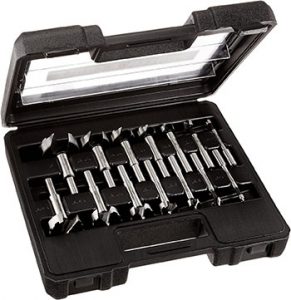
If you’re going to stick with woodworking for more than a few years, trust me you’ll need multiple sizes of Forstner bits out of sheer necessity. So, here’s a set 14-piece including common sizes ranging from 2 inches. Having an open tooth design, all of them cut great and fast. Leave a fine smooth finish without jagged edges.
Being made from hardened steel, you can’t question their durability and service life. So, if you are looking for a Forstner bit set, pull the trigger on this one, you’ll be glad you did.
3. Freud Precision Shear Serrated Edge
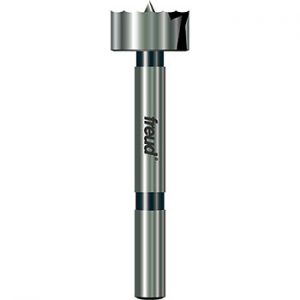
Featuring a unique geometric design that has multiple cutting edges for greater shearing action, faster rotational speeds, and more efficient cutting. It has less splintering and chipping so your precious work won’t get ruined. The ultra-sharp spur in the middle guides through the wood reliably preventing any slipping on the top of the surface.
Like the previous one, its body is made of hardened steel too for a sharper edge and longer life.
What Are the Best Spade Bits?
Now, if your work requires paddle bits, here are some of the most effective ones to get your job done.
1. DEWALT Drill Bit Set
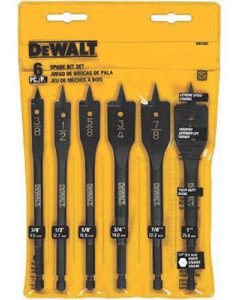
This is a 6-piece set of spade bits having all the common sizes ranging from to 1 inch for multipurpose use. To make it compatible with most of the drills it features an inch ball groove shank. So these well-made bits can be a nice addition to your toolbox for fast boring operations.
2. WORKPRO 13-Piece Spade Drill Bit Set

If you need a more versatile set than the previous one, consider getting this one with 13 pieces. The sizes starting from all the way to inches. Featuring a head with high-quality double side cutting spurs and a quick-change hex shank, it’s perfect for easy and quick drilling.
The bits are constructed from heat-treated carbon steel for longevity. There will be no fitment issue as the hex shank is an inch that goes with most drill driver tools.
3. DEWALT Drill Bit
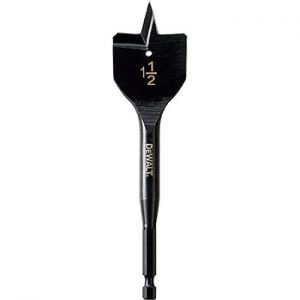
Here’s another paddle bit from DEWALT that can dig clean recessed holes. It features a heavy-duty shank for maximum durability. Also, the bit prevents walking or slipping on the surface and fits all-inch quick-change systems. The inches blade is enough for a cable installation project.
Conclusion
Hopefully, you have understood the difference between the Forstner bit vs spade bit. Not only their design but also their precision, speed, application, and cost differ a lot. So, decide which one you need for your woodworking project keeping their dissimilarities and usage in mind.

